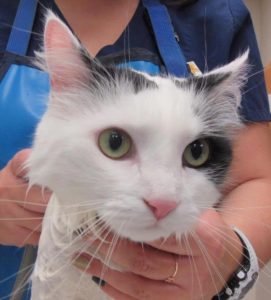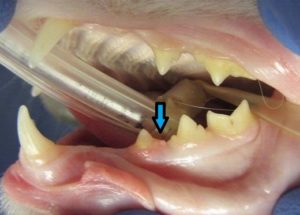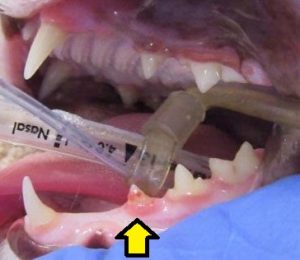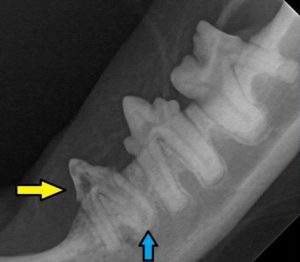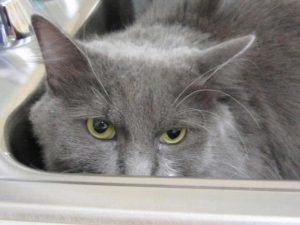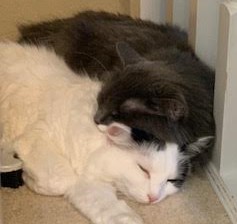
For August, our Pets of the Month are Luna and Mia! These two sweet kitties are sisters and share many things, including a dental condition called tooth resorption.
Tooth resorption is a dental condition affecting cats, dogs, and people. Cats seem to be affected more commonly than dogs or humans. Up to 70% of cats over the age of 5 years have tooth resorption. Tooth resorption is when the body’s own cells (odontoclasts) start eating away or “resorbing” the tooth. Odontoclasts are normal cells in the body and have important functions. For instance, when the deciduous or baby teeth are being replaced by adult teeth in kittens.
The question is why are these cells active when they shouldn’t be? The answer is we do not know why exactly. In some cases, it appears that chronic inflammation (like periodontal disease) is responsible. Good dental home care (like tooth brushing) will help prevent some but not all tooth resorption.
Tooth resorption can start in the crown (the part of the tooth we see in the mouth) or the roots (below the gingival margin and not visible). Based on reports from people, we do not believe that tooth resorption in the roots is painful. If only the roots are affected, the tooth is left alone and monitored with radiographs.
When the resorption starts to affect the crown, it exposes the sensitive pulp and dentin which can cause extreme pain. The body reacts by trying to cover the defect with gingiva or granulation tissue. Your veterinarian will be able to see this during your cat’s exam, and be able to diagnose a resorptive lesion.
It was during one of Mia’s and Luna’s bi-annual exams that the veterinarian diagnosed each of them with tooth resorption.
A veterinarian may also be suspicious of tooth resorption when a tooth has gingivitis but no tartar. Some cats have no changes that can be seen during an awake oral exam. Remember, up to 70% of cats over 5 have some tooth resorption. Many times, it requires radiographs to diagnose this condition. This is why cats over the age of 3 years of age should have yearly dental radiographs, an oral exam, and cleaning under anesthesia.
The goal is to detect this painful condition and treat it before there is pain.
Are there ways that owners can detect dental pain in their cats? Like with many things involving our feline friends, the answer is a resounding… sometimes! Remember cats are a prey species (as well as mighty hunters!), so their instinct is to hide pain. We as humans are generally very bad at understanding our cat’s body language and facial expressions. This combination means that many times we miss signs of pain or discomfort in our cats.
Cats with tooth resorption may have changes in their behavior such as decreased grooming, picking at and dropping food, pawing at mouth, hiding, lethargy, sticky mucus on the lips, head shaking, rubbing the mouth on the ground, and teeth grinding. However, the lack of these signs does not mean that there are no resorptive lesions or that they are not painful. The majority of cats affected by this condition show no outward signs of discomfort.
Remember all those “cute” cat videos of cats eating ice cream and getting “brain freeze”? Those cats all have oral pain and most likely have tooth resorption. This is how easy it is to misinterpret signs of pain in our cats. This is why your cat needs yearly anesthetized dental radiographs, oral exams, and cleanings! The goal is to provide a pain free mouth for our feline companions.
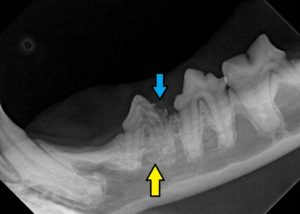
Blue arrow points to the erosion in the crow of the tooth. The yellow arrow points to the resorbing root.
Now that we have diagnosed tooth resorption, we need to treat the tooth. If the tooth resorption is only affecting the roots, then we do not treat it. Instead, we recheck radiographs in a year. The radiographs are monitoring the progression. Once it is affecting the crown, or is very near the crown, the tooth needs to be extracted.
The only treatment we have available for tooth resorption is to extract the affected tooth. Other treatments have been tried but none have stopped the disease progression. Removing the tooth, removes the source of the pain and gives your cat a comfortable mouth.
Yes, cats can eat normally (including hard kibble) without teeth! Remember, these teeth are extremely painful, so they are already avoiding chewing with them. Both Mia and Luna had their affected teeth extracted. They are now closely monitored for additional tooth resorption with bi-annual veterinary exams and yearly dental radiographs.
Here is a list of ways to ensure your feline friend’s mouth stays pain free and healthy:
- Brushing Teeth Daily (single best thing to take care of your cat’s teeth): how-to-brush-your-cats-teeth/
- Other Home Dental Care Products (such as dental diets, treats, water additives).
Here is a link to a comprehensive list: VOHC Accepted Products for Cats
- Regular Veterinary Exams every 6 Months
- Yearly anesthetized dental radiographs, oral exams, and cleanings
Resources:
Why Does My Cat Need Veterinary Dental Care
Dental Care in Cats – Dr. Jan Bellows
Know the Facts About Anesthesia Free Dentistry – Why It Is a Poor Choice

